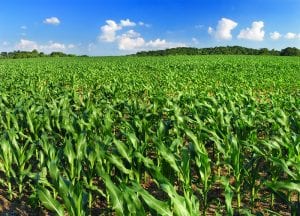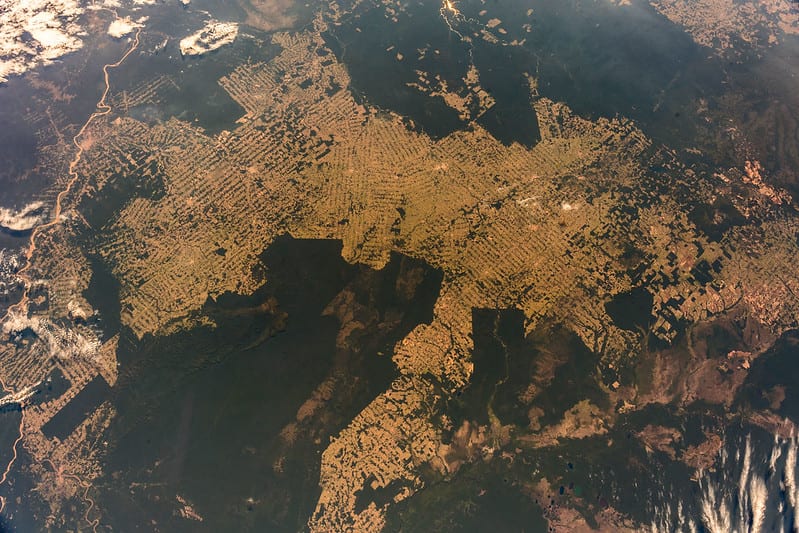How Does Animal Grazing Cause Soil Erosion
Industrialized Meat Production and Country Degradation: 3 Reasons to Shift to a Plant-Based Diet
The earth now produces more than four times the quantity of meat it did 50 years ago. In the The states, information technology is estimated that seventy% of cows, 98% of pigs, 99% of turkeys, and 98% of chickens and eggs come from factory farms, co-ordinate to a 2017 USDA report. And all of these factory farms have a tremendously detrimental touch on on both our country availability and soil health. Industrialized livestock production uses a significant corporeality of country surface – 26% of the World'southward ice-gratis land is used for livestock grazing, and one-third of the planet's arable (farmable) country is occupied by crops for livestock feed, according to the Un Nutrient and Agronomics Organisation.
When comparing global land utilise of a meat-based diet to a establish-based diet, industrialized livestock grazing and growing livestock feed (primarily corn, soy, and oats) uses two and a half times more state than a plant-based diet. In the U.S., more than than lxx% of soy, eighty% of corn, and 95% of oats that are grown are fed to livestock. Consuming a constitute-based nutrition isn't only a more efficient use of express state resources, merely also reduces the numerous negative impacts industrialized livestock product has on soil wellness. We explore some of these negative furnishings beneath.
Three negative effects of industrialized livestock product on country-use and soil health
 1. Overgrazing and Soil Erosion
1. Overgrazing and Soil Erosion
In the U.South., industrialized livestock product is direct responsible for 85% of all soil erosion. (Although soil erosion is a naturally occurring procedure, it has accelerated due to unsustainable livestock over-grazing.) Soil erosion occurs when grasslands are subject to extensive grazing without sufficient recovery periods. In addition, if as well many animals are grazing the same state area, the damage their hooves cause to the soil is devastating. Equally vegetation is removed from the state by livestock activeness, the soil becomes exposed to water and air current and is easily swept abroad. Every bit highlighted by World Wild animals Fund, "The effects of soil erosion go beyond the loss of fertile country. It has led to increased pollution and sedimentation in streams and rivers, bottleneck these waterways and causing declines in fish and other species. Degraded lands are likewise often less able to hold onto water, which tin can worsen flooding."
 2. Overfarming and the Impact of Monoculture Farming
2. Overfarming and the Impact of Monoculture Farming
With the continued growth of industrialized livestock product, livestock feed at present consists primarily of corn, soy, and oats. These high-protein/high-energy foods allow animals to achieve market place weight quickly and are much cheaper for farmers than other food options. Of all agricultural country in the U.Southward., 87% is used for industrialized livestock production. Farmers working inside the industry tend to apply monoculture to meet need, an unsustainable farming do. Monoculture is detrimental to soil wellness because as the same institute is grown annually on the same plot of land, the available diet plant in the soil is gradually reduced. To supplement this depletion, farmers utilize fertilizers and pesticides, which accept numerous residuum impacts, including the pollution of waterways and decline in pollinator populations.

iii. Deforestation To Brand Way for More Pastures
Equally available arable land and nutrient-rich soil decrease due to erosion and over-farming, an increase in demand for meat consumption incentivizes companies to clear-cut rainforests, making way for industrialized livestock production. According to the Union of Concerned Scientists, "converting wood to pasture for beef cattle, largely in Latin America, is responsible for destroying 2.71 million hectares of tropical woods each twelvemonth –an area almost the size of the land of Massachusetts – in just four countries." Equally trees are deforested, the soil loses protection from tree awning comprehend and root systems, exacerbating soil erosion. Deforestation destroys natural habitats of plants and animals, resulting in a decrease of biodiversity. Additionally, the potential carbon that trees absorb and shop decreases, contributing to climate modify.
Transitioning to a More than Plant-based Diet
The demand for meat and other animate being products drives growth in industrialized livestock production, which directly influences the degree to which soil erosion, over farming, and rapid deforestation occur. Reducing the consumption of meat and increasing plant-based diets can have positive, lasting effects on state use and soil health. Agreement these cause and event relationships is vital to preserving our limited country resource and ensuring sustainability of our planet.
Prototype credits: Field erosion (USDA NRCS Montana); Cornfield Monoculture (Nicholas A. Tonelli, CC BY 2.0); Aeriform view of Amazon deforestation (Alexander Gerst: ESA/A.Gerst, CC BY-SA 3.0 IGO)
Almost Population Teaching
Population Education provides K-12 teachers with innovative, hands-on lesson plans and professional development to teach about homo population growth and its effects on the environs and human well-being. PopEd is a program of Population Connection. Learn More About PopEd.
Source: https://populationeducation.org/industrialized-meat-production-and-land-degradation-3-reasons-to-shift-to-a-plant-based-diet/
Posted by: shiressucarty.blogspot.com

0 Response to "How Does Animal Grazing Cause Soil Erosion"
Post a Comment